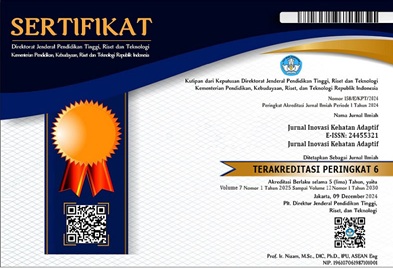PENERAPAN WATER TEPID SPONGE UNTUK MENGATASI HIPERTERMI PADA ANAK DENGAN DEMAM TYPOID DI RUANG FLAMBOYAN RSI PKU MUHAMMADIYAH PEKAJANGAN PEKALONGAN
Kata Kunci:
Water Tepid Sponge, Hipertermi, demam typoid, Hyperthermia, typhoid feverAbstrak
Latar belakang: Demam typoid ialah penyakit infeksi akut yang menyerang saluran pencernaan yang disebabkan oleh Salmonella typhi ditandai dengan demam yang berlangsung lebih dari satu minggu. Salah satu tindakan non farmakologi untuk menurunkan demam adalah water tepid sponge. Water tepid sponge yaitu kompres blok tidak hanya disatu tempat, melainkan langsung dibeberapa tempat yang memiliki pembuluh darah besar, S disertai pemberian seka pada seluruh tubuh. Tindakan ini akan mempercepat pelebaran pembuluh darah perifer dan menfasilitasi perpindahan panas dari tubuh ke lingkungan sekitar sehingga mempercepat penurunan suhu tubuh. Tujuan: Mengetahui pengaruh penerapan water tepid sponge untuk mengatasi hipertermi pada anak demam typoid Metode: Metode penelitian karya ilmiah ini menggunakan metode studi kasus berdasarkan penerapan Evidence Based Praktice (EBP) responden yang digunakan adalah pasien anak toddler dengan masalah keperawatan hipertermi. Studi kasus dilaksanakan 4 hari sejak tanggal 15 sampai 18 Januari 2024. Hasil: Hasil penelitian didapat setelah pasien anak dengan hipertermi diberikan tindakan water tepid sponge didapatkan data pada hari pertama sebelum dilakukan water tepid sponge suhu tubuh 38,4℃ dan setelah dilakukan tindakan water tepid sponge suhu tubuh menjadi 37,2℃. Pada hari kedua sebelum dilakukan tindakan suhu tubuh 38,2℃ dan setelah dilakukan tindakan menjadi 37℃. Pada hari ketiga suhu tubuh 36,4℃ yang menunjukkan suhu tubuh sudah normal dan hari ke empat suhu tubuh 36,5ºC. Simpulan: Water tepid sponge mampu menurunkan masalah hipertermi pada anak dengan demam typoid.
Background: Typoid fever is an acute infectious disease that attacks the digestive tract caused by Salmonella typhi characterized by fever that lasts more than one week. One of the non- pharmacological measures to reduce fever is water tepid sponge. Water tepid sponge is a block compress in several places that have large blood vessels, accompanied by the provision of wipes throughout the body. This action will accelerate the dilation of peripheral blood vessels and facilitate the transfer of heat from the body to the surrounding environment, thus accelerating the decrease in body temperature.Objective: To determine the effect of the application of water tepid sponge to overcome hyperthermia in children with typhoid fever.Methods: This scientific research method uses a case study method based on the application of Evidence Based Practice (EBP). Respondents used are toddler patients with hyperthermi nursing problems. The case study was conducted for 4 days from January 15 to 18, 2024. Results: The results of the study obtained after pediatric patients with hyperthermia were given water tepid sponge action obtained data on the first day before the water tepid sponge was done the body temperature were 38.4 ℃ and after the water tepid sponge action the body temperature became 37.2 ℃. On the second day before the action, the body temperature was 38.2 ℃ and after the action it became 37 ℃. On the third day, the body temperature was 36.4℃ which showed that the body temperature was normal and on the fourth day, the body temperature was 36.5ºC. Conclusion: Water tepid sponge can reduce hyperthermia problems in children with typoid fever.





